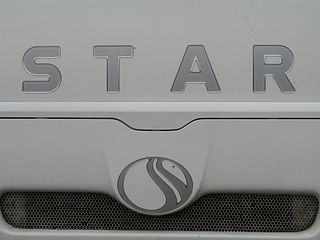
Zust was an Italian car manufacturing company operating from 1905 to 1917.
Anglada was a Spanish automobile manufactured in Puerto de Santa María in Cádiz, Andalucia from 1902 to 1905. The company named Anglada. Fábrica de bicicletas y automóviles was founded by Francisco Anglada y Gallardo. Anglada made expensive cars by individual order. The cars were either one- or four-cylinder models ranging from 6 to 36 cv. Anglada is notable today, if at all, for producing the first Spanish car purchased by Alfonso XIII; the King bought a 24 hp (18 kW) four from the company in 1904. Although the Spanish aristocrats bought some cars, due to financial problems, Francisco Anglada soon gave up production. He opened an automobile repair shop in Madrid. Francisco Anglada died in 1917.

The Energy Policy Act of 1992, effective October 24, 1992, is a United States government act. It was passed by Congress and set goals, created mandates, and amended utility laws to increase clean energy use and improve overall energy efficiency in the United States. The Act consists of twenty-seven titles detailing various measures designed to lessen the nation's dependence on imported energy, provide incentives for clean and renewable energy, and promote energy conservation in buildings.

The P4 is an unarmoured off-road vehicle used by the military of France. It was manufactured by Peugeot but is now manufactured by Panhard. It is to be replaced with the PVP by Panhard. The P4 is a derivative of the Mercedes Geländewagen military version built under license by Peugeot for the French military. Peugeot did not have a licence to export the vehicle anywhere else than to the countries bound to France by defence agreements.

Fabryka Samochodów Ciężarowych "Star", also known simply as Star, was a Polish truck manufacturer. The name comes from the City of Starachowice, where the factory is located. Their first vehicle was the Star 20 in 1948. The most popular product was the Star 266. The 266 model offered very good quality and powerful engines for a low price. It was sold in various countries for many years. For many years, FSC Star was a state-owned company. Star is now owned by MAN AG who retired the brand in January 2009.
Lam Eng Rubber Factory (M) Sdn. Bhd. is a Malaysian manufacturer of natural rubber.
Electrorides Inc is an electric vehicle maker, based in Laguna Niguel, California. The company founder and CEO is Tedd Abramson. Electrorides Zerotruck debuted at the Alternative Fuels & Vehicles National Conference and Expo in Las Vegas May 11–14, 2008.

Rootes Australia was the Australian affiliate of the Rootes Group, a British motor vehicle manufacturing company.

The M25 tank transporter (G160) was a combination 6x6 M26 armored heavy tank transporter/tank recovery tractor and companion 40-ton M15 trailer introduced into US Army service in Europe in 1944–45. Manufactured by Pacific Car & Foundry Co., it was a substantial upgrade over the Diamond T M19 transporter/trailer duo introduced in 1940.
Christine Adamo is a French writer who comes from the world of the sciences. Specialized in environmental information, she writes thrillers which cross science, history and suspense.

The Holden EK series is a motor vehicle produced by Holden in Australia from 1961 to 1962. Introduced on 2 May 1961, the EK series was a facelifted version of the Holden FB, which it replaced.

The Armoured Engineer Reconnaissance Vehicle (AERV) is an Indian military engineering vehicle developed by Defence Research and Development Organisation (DRDO) in coordination with C-TEC, as per General Staff Qualitative Requirements (GSQRs) of the Indian Army for enabling the combat engineers to conduct recce operations.
The United Kingdom, where the Industrial Revolution began in the late 18th century, has a long history of manufacturing, which contributed to Britain's early economic growth. During the second half of the 20th century, there was a steady decline in the importance of manufacturing and the economy of the United Kingdom shifted toward services. Manufacturing, however, remains important for overseas trade and accounted for 44% of goods exports in 2014. In June 2010, manufacturing in the United Kingdom accounted for 8.2% of the workforce and 12% of the country's national output. The East Midlands and West Midlands were the regions with the highest proportion of employees in manufacturing. London had the lowest at 2.8%.
The Besal, properly named "Gun, Light, Machine, Faulkner, .303-inch", was a light machine gun of British origin. The weapon was intended as an alternative to the Bren gun as it was lighter, simpler, cheaper and easier to manufacture and therefore was not dependent on the Royal Small Arms Factory, Enfield which was within range of German bombers. As the threat to the supply of Brens receded, it was eventually deemed unnecessary and never went into mass production.
Badminton has been part of the Arab Games since 1999 in Amman, Jordan. Syria tops the medal table, having won 15 gold medals, 3 silvers and 3 bronze medals. Algeria won four golds and two silvers while Egypt won a gold, three silvers and six bronzes. Sudan won its first medal in badminton at the 2007 Pan Arab Games.
ELISA is a suite of four French military satellites launched on 17 December 2011 from Arianespace's Kourou spaceport in French Guiana. It consists of microsatellites ELISA 1, ELISA 2, ELISA 3, and ELISA 4
Brahm Prakash, was a metallurgist known for his work with nuclear materials in India.
The FR Yugoslavia, then Serbia and Montenegro, Chess Championship was organized by the FR Yugoslavia and then Serbia and Montenegro Chess Association.

The White AM armoured car was a French First World War armoured car that was built on a commercial American White Motor Company truck chassis with armoured bodies supplied by the French firm Ségur & Lorfeuvre, it was used by the French military from its introduction in 1915. Between the wars the French military completely rebuilt the vehicles as the White-Laffly AMD 50 and the Laffly-Vincennes AMD 80, in these guises it served until at least 1943.









